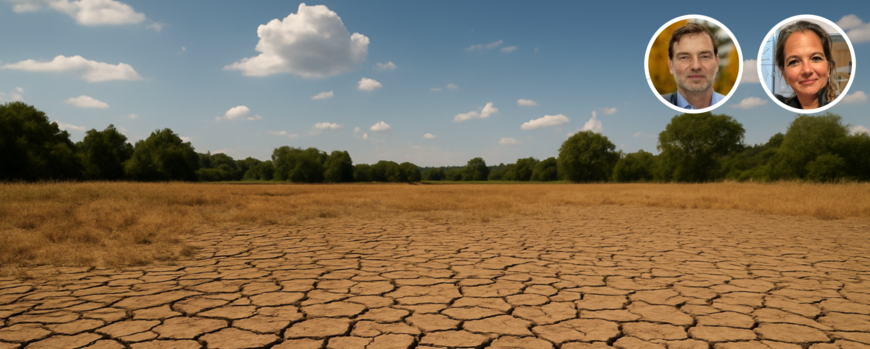10 questions on droughts for Prof. Sascha Oswald (environmental scientist at the University of Potsdam) & Prof. Sabine Attinger (hydrologist at the Helmholtz Centre for Environmental Research (UFZ) and the University of Potsdam)
- What are the specific characteristics of a drought?
Droughts are periods during which soils, groundwater, rivers and lakes contain significantly less water than usual, or during which there is particularly little precipitation. These dry periods can be particularly intense, long-lasting or widespread – or a combination of these factors. It is important to note that droughts are not simply ‘dry climates’ like those found in deserts, but rather temporary extreme deviations from normal conditions. - Which regions of Germany are particularly vulnerable to droughts, and why?
Droughts affect all regions of Germany – they are part of natural fluctuations. However, climate change is making these periods more frequent, more intense and longer lasting. We have already seen this in recent years. - Does prolonged drought have an impact on groundwater and thus also on our drinking water?
Yes. When there is a prolonged dry spell, water demand increases, for example for irrigation in agriculture or in gardens. This is also reflected in drinking water consumption. At the same time, less water seeps down into the ground, which means that groundwater is replenished less. In the long term, this can certainly have an impact on the availability of drinking water. - To what extent can agriculture adapt to more frequent droughts?
Agriculture can respond in various ways: by growing crops that are more tolerant to drought, by reducing evaporation, or by using more intensive, albeit economical, irrigation methods. Which measures make economic sense depends largely on the location and its conditions. - How do droughts and heat waves affect public health?
Heat waves pose a health risk, especially for older people, children and people with pre-existing conditions. The direct impact of droughts on health in Germany is still difficult to quantify. In some other regions of the world, especially in the Global South, extreme drought can be life-threatening for many of those affected. - What strategies could help to sustainably reduce water consumption in agriculture, industry and households?
Germany is generally a country with abundant water resources. Nevertheless, water demand is rising in some regions and during hot summers. This calls for good water management: rainwater storage, green cities, restrictions on excessive consumption and efficient use, especially in agriculture. - Which successful measures against drought from other countries could be transferred to Germany or similar regions?
It is important to note that climate protection is the best protection against drought. In addition, measures such as rainwater harvesting, adapted urban planning, forest conversion and the cultivation of suitable plants can help. Nevertheless, we need our own solutions for Germany that are tailored to our conditions. - Is nature capable of adapting to fluctuating climatic conditions?
Ecosystems change with the climate. Some species disappear, while others – such as drought-resistant or invasive species – spread. In some regions, this can lead to a decline in biodiversity. In Germany, the risks have been limited so far, but in southern Europe, the danger of fundamental upheaval is real. - How is climate change altering the frequency of droughts in Germany? Are we already seeing this?
Yes, we are seeing a clear trend: temperatures are rising and droughts are occurring more frequently. However, this does not mean that every year is dry – there are still wetter years. Nevertheless, the trend is clear, and the sooner we reduce emissions, the better. - How relevant are droughts in other countries to us?
Droughts abroad affect us directly – through global supply chains, migration, food prices and political instability. Our world is interconnected, which is why even distant droughts have an impact on Germany.
Prof. Dr. Sascha Oswald
Professor of Subsurface Hydrology
Institute of Environmental Science and Geography, , University of Potsdam
Prof. Dr. Sabine Attinger
Head of Department of Computational Hydrosystems

